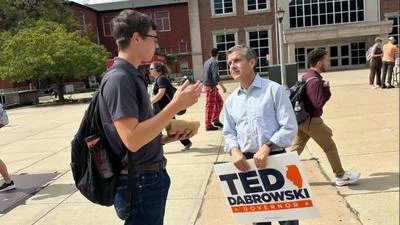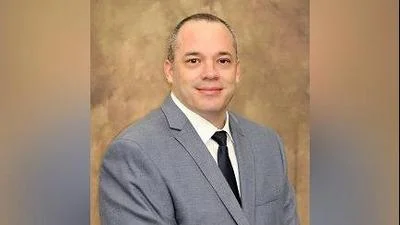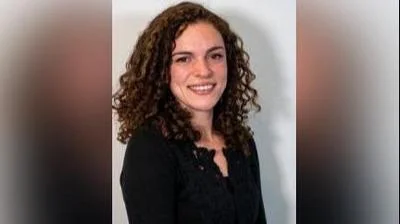Community Unit School District 200 Board of Education Committee of the Whole Met Feb. 24.
Here is the minutes provided by the committee:
The Committee of the Whole meeting of the Board of Education of Community Unit School District 200, DuPage County, Illinois, was called to order at the Hubble Middle School, 3S600 Herrick Rd Warrenville, IL, by Board President Brad Paulsen, on Wednesday, February 24, 2021, at 7:00 PM.
ROLL CALL
Upon the roll being called, the following were present:
Board Members: Mr. Brad Paulsen
Mrs. Chris Crabtree
Mr. Rob Hanlon
Mrs. Susan Booton
Mrs. Ginna Ericksen
Mr. Dave Long
Absent: Mr. Jim Mathieson
Also in Attendance: Dr. Jeff Schuler, Superintendent
Mr. Bill Farley
Dr. Charlie Kyle
Mrs. Erica Loiacono
Mr. Rodney Mack
Mrs. Melissa Murphy
Dr. Chris Silagi
PLEDGE OF ALLEGIANCE
Assistant Superintendent Chris Silagi led the Board and community in the Pledge of Allegiance.
SUSPEND THE RULES AND ADJOURN TO WORKSHOP SETTING
MOTION
Member Crabtree moved, Member Ericksen seconded to suspend the rules and adjourn to a workshop setting. Upon a roll call vote being taken the vote was: AYE 6, NAY 0. The motion carried 6-0.
STATEMENT FROM BOARD PRESIDENT
President Paulsen reminded all this is a Committee of the Whole meeting that allows the District Administration to present on topics that are central to the instructional programs and overall operation of the school district. The focus of the meeting will be two important items. First, as a continuation of the Return to Learn Work Plan discussed in depth at the last few meetings, plans will be introduced to address the learning needs of students during the spring, summer, and fall.
This will be introduced as our Learning Acceleration Plan. An update on the Equity Work Plan that was approved by the Board last fall will also be provided.
It was noted the Board of Education is thankful that every one of our District 200 schools is open and complying with the mitigation strategies established for a safe learning environment for students, teachers, and staff. The District’s layered mitigation strategies are consistent with CDC guidance and recently confirmed by the DuPage County Health Department. The District has made progress in bringing more students into schools based on the parameters and strategies previously presented and agreed upon by the Board. Progress continues to be made on the overall Return to Learn Plan which includes bringing students back for 5-days per week, in person learning. The administrators were commended for their efforts to work through the myriad details and complexities to make this possible.
Dr. Schuler noted the following:
∙ All of the plans are anchored around the expectation that students will be back in buildings full-time next school year, based on the expectation that physical distancing mitigations will be adjusted by that point.
∙ Currently operating with a strict six-foot physical distancing mitigation as required by CDC and DCHD (based on our current community levels).
∙ All HS seniors that expressed interest in coming back four days per week will be brought back next week. Work continues to identify “needs-based” students and moving focus to other HS class levels based on the interest survey, accommodating as many students as possible based on the six-foot distancing and the use of additional rooms as overflow spaces.
∙ The Class of 2021 Committee has continued to meet and plan in-person opportunities to celebrate seniors. Graduation ceremonies will take place on the scheduled date of May 29, 2021, on the HS football fields. Specific details will be released as the date gets closer.
∙ MS – until the physical distancing standard is adjusted, the number of in-person days will likely not be able to be significantly increased.
∙ Two documents were provided to the Board that were recently released by the CDC and affirmed by the DCHD. This updated guidance is significant as a result of a change that does create a path for future flexibility in the physical distancing standard (based on reduced community transmission levels).
∙ The importance of trend data related to transmission numbers when making decisions about moving between levels of the CDC framework.
∙ Based on the new information and planning for the March 10 Board meeting, Dr. Schuler asked the Board to affirm the desire to review a plan responsive to this information (including what and how we can make adjustments).
Instruction
Learning Acceleration Plan
The COVID-19 pandemic has impacted students in all different ways. Community Unit District 200 is taking a comprehensive approach to analyze all students' needs and determine programming for the remainder of this school year, this summer, and next year to accelerate learning due to the altered year. Assistant Superintendent Melissa Murphy and members of the Educational Services leadership team provided a presentation on the Learning Acceleration Priorities and Plans.
The presentation provided an overview of the key priorities District 200 has selected to design programming that addresses learning acceleration. All plans are aligned to several metrics on the Student Learning portion of the Vision 2022 data dashboard. District 200's approach includes analyzing multiple data sources and engaging our community to determine the state of student learning and the impact of an altered year. District 200 programming will focus on what we continue to do this year, what we can do over the summer, and plans for the next school year.
The presentation included the following:
∙ District Statement, Focus, and Plan
∙ Teachers Hard Work This Year – Parent Comment
∙ Guiding Questions:
o What are the key priorities to consider in accelerating student learning?
o How will we identify students in need of additional supports?
o What are our plans to accelerate student learning for the remainder of this year, this summer, and next year?
∙ CUSD 200 Approach – Analyzing & Identifying Six Key Priorities to Focus Planning and Advance All Students
∙ Advance 200 Key Priorities
o Whole Child Approach
▪ The individual needs of students are essential to learning
▪ The need to fully understand students’ needs, challenges they are facing, and their wellness and mental health needs
o Meet the Needs of All Students
▪ No matter the learning environment, all students need to have opportunities to continue high-quality learning that includes differentiation and individualization
o Start with Those Most Vulnerable
▪ Younger, lower-income students, multilingual learners, and those who have been most disconnected from school have been the hardest hit by the pandemic
o Ensure Attendance and Engagement
▪ Essential to learning at high levels
▪ Regular attendance serves as a predictor of academic success
▪ Current learning environments have changed the landscape, and some students need targeted support in this area to thrive
o Use Assessment to Prioritize Learning
▪ Formative assessment is essential to responsive teaching
▪ Ongoing checkpoints – including observing, listening, and asking questions
▪ A critical component to helping teachers make adjustments to lessons to accelerate student learning
o Accelerate or Integrate, Don’t Remediate
▪ All students must have the opportunity to learn at a high level
▪ Grade-level content and instructional rigor are the academic priority
▪ Focus on acceleration and commitment to grade-level teaching
▪ The need to be intentional in integrating content from the previous grade and providing scaffolds and supports to determine how students enter grade-level topics
o Vision 2022 Dashboard Metrics Focus our Efforts to Identifying Student Needs
▪ Elementary Metrics
▪ Elementary Focus & Data Points
▪ Middle School (MS) Metrics
▪ MS Focus & Data Points
▪ High School (HS) Metrics
▪ HS Focus & Data Points
▪ Comprehensive Data Analysis: Specialized Populations
▪ Comprehensive Data Analysis: Community Engagement Opportunity
o Plans to Accelerate Student Learning for Remainder of This Year, This Summer, and Next Year
o Phase 1: Now-End of the School Year (Programming and plans aligned to all key priorities and dashboard metrics)
▪ % of K-12 Students with at Least 90% Attendance
∙ Student Identification
∙ Targeted Interventions
∙ Expanding Time
▪ K-8 Reading and Math
∙ Additional Interventions
∙ Expanding Time
∙ Diagnose and Identify Learning Needs
▪ Freshman on Track and Graduation Rate
∙ Extending Learning (both virtually and in-person) to support identified students with multiple opportunities.
o Phase 2: Summer (Programming and plans aligned to all key priorities and dashboard metrics)
▪ K-8 Reading and Math
∙ Summer Learning for All
∙ Intensive Tutoring
∙ Acceleration Academy
∙ Specialized Program
▪ Freshman on Track and Graduation Rate
∙ WWSHS and WNHS will offer multiple summer learning opportunities for students in grades 9-12, including:
o Online Summer School (formerly “eLo”)
o Summer Term
o Freshman Support Bridge Courses
▪ % of Graduates with a “C” or Higher in at Least One AP or Dual Credit Course
∙ WWSHS and WNHS will offer multiple summer learning opportunities for students in grades 9-12, which may include:
o Freshman Summer Bridge to Advanced Level Courses
o AP Inspiring Excellence Summer Bridge & Enhanced Recruiting
o Teacher Recommendations for Summer Bridge if at risk of dropping to I-Level
o Phase 3: 2021-2022 Framework for Action
▪ 1. Form a Core Learning Recovery Planning Team
▪ 2. Develop Specific Plans Focused on Acceleration of Learning
▪ 3. Train Teachers and Leaders on Best Practices
▪ 4. Continue to Monitor Student Progress and Support Implementation
Information was added on the following:
∙ The focus is on moving forward and planning for the future by putting structures in place that support recovery and long-term rebuilding to advance D200.
∙ Wanting staff members to know the hard work that has been put into the school year is recognized and the need to recover any learning loss is not a result of the teachers not working hard or trying hard enough.
∙ Scaffolds – supports teachers put in place so students can be successful. An example may be using pictures or adjusting the language to assist with a word problem to support students that are not at grade-level reading.
∙ Disengaged VA students continue to be a primary focus at the elementary level.
∙ Elementary data points include attendance, change in district assessment scores, teacher recommendation, and English proficiency as measured by ACCESS for multilingual learners.
∙ The group targeted for A-level classes for incoming freshman students was smaller and less diverse than typical – the criteria has been adjusted and a summer learning opportunity was designed to help bridge students into their advanced classes.
∙ MS data points include attendance, change in grades, trends in District assessment scores, and teacher recommendation.
∙ HS data points include attendance; change in grades, credit standing or GPA; change in course registration; and teacher recommendation.
∙ Specialized populations include students with an IEP, 504 plan, or multilingual learners.
∙ Specialized population data points include attendance, FastBridge data, IEP goals/benchmark data, grades, risk of harm data, SEL referral data, ACCESS data, and team recommendations.
∙ Thought Exchange tool will be used to ask stakeholders two questions that will determine our most significant opportunities and challenges:
o 1 – What are the positive outcomes of this year for our students?
o 2 – What are the needs that we see?
∙ MS level – created a continuum of interventions to address chronically absent students strategically.
∙ Increase in enrollment in the VA at the MS level, starting with the second semester – therefore looking to expand sections for reading and math lab opportunities.
∙ MS Day Academy – made a pivot for those students that had difficulty attending regularly. These students are now enrolled in Edgenuity courses so they have a teacher that works with them for support and coaching through those courses.
∙ Grades 1-7 Reading and Math – intensive tutoring is one of the most effective ways to help accelerate student learning.
∙ Students identified for “summer term” at the HS level will complete the work required to get a passing grade. Teachers will submit plans at the end of the school year for students who need to recover assignments to pass a course.
There were questions, comments, and/or discussion on the following:
∙ Staffing for summer months – internal or having to look outside of the district?
∙ Communicating this out to families as soon as possible for scheduling purposes.
∙ Thought exchange and getting specific feedback from Virtual Academy (VA) families.
∙ How are District assessments playing a part with our VA students so we have a true idea of where they are at?
∙ What types of assessments will take place this Spring?
∙ Assessments for special education population.
∙ If students are doing okay and are not identified for extra work, is it possible for them to get extra work?
∙ Percentage of students that may participate in summer learning; the District goal is 100% of the students identified as having a need.
∙ Creating a social-emotional referral system for both VA and in-person learning environments. This is building on systems and infrastructure the District had in place and carried over to VA.
∙ Summer opportunities – planning on taking place in person at buildings.
∙ Reviewing the possibility of providing to parents something in the way of enrichment for parents/students that feel they have not gotten as much from this school year.
∙ Report cards – ensure the language is understandable and reader-friendly.
∙ Important to incorporate student feedback and hear their voice – the possibility of using student focus groups as related to learning loss.
∙ Providing transportation for summer services to eliminate barriers for those that need it.
∙ The shift in terminology from learning loss to learning acceleration.
∙ Allowing students and families to address learning challenges – supporting and encouraging them to embrace this opportunity.
∙ This is a comprehensive plan with a lot of moving parts – important to ensure there is a deep communication plan.
∙ The need to remember there are a lot of positive things that have come from this year – including perseverance, grit, life skills, problem-solving skills, etc.
∙ The learning acceleration plan is academically oriented. Is there potential for a summer program to be focused on emotional wellness?
∙ What does the plan look like if the CDC guidance is adjusted?
∙ Ensuring the plan is sustainable.
∙ Giving our students, parents, and staff an idea of what the balance of the year will look like as soon as possible for each one of our levels.
∙ Adjustments continue to be made to learning plans and will continue to do so as opportunities exist to make these adjustments. This is a continuation of the process. ∙ Every school district in the county and state is working through iterations of their plan as the guidelines are adjusted. The plan helps us understand what we can do when we arrive at that point.
∙ The expectation for the March 10 Board meeting is to have the plan laid out consistent with specifics noted in the framework that has been established.
Equity Work Plan Update
During the 2019-2020 school year, the District 200 Senior Leadership Team conducted a series of dialogues with the EC-12 leadership team on equity in our schools. The Administrative team also created an equity work plan to outline significant tasks for the 2020-2021 school year. This plan includes priorities for professional learning, restorative practices, curriculum and programming, social-emotional learning, diverse hiring practices, and family and community engagement. Additionally, an equity task force consisting of administrators, teachers, parents, community members, and a school board member was formed this year to provide recommendations to advance equity practices in District 200.
The Administration provided the Board of Education with an update on items included on the equity work plan and the recommendations provided by the task force, which included information on the following:
∙ Defining Equity
∙ District 200 Equity Plan – Recent Work and Updates
o Equity Task Force Overview and Updates
o Equity Work Plan
∙ Equity Task Force
o Makeup of the task force
o Equity practice roles for CUSD 200 stakeholders
∙ Equity Mission & Practice
o Equity Practice = Identifying and Discontinuing Inequities
∙ Recommendations from the Equity Task Force
o Board Member Equity Practice Role
o Administrator Equity Practice Role
o Teacher Equity Practice Role
o Student Equity Practice Role
o Parent & Community Member Equity Practice Role
∙ CUSD 200 Equity Work Plan – includes priorities for:
o Professional Learning
o Restorative Practices
o Curriculum and Programming
o Social-Emotional Learning
o Diverse Hiring Practices
o Family and Community Engagement
∙ Crosswalk of the Task Force Outcomes and D200 Work Plan
∙ Equity Framework
o Curriculum, Instruction, Assessment & Professional Development
o Student Voice, Culture & Climate
o Systemic Equity
o Employment & Retention
o Family & Community Engagement
∙ Professional Learning
o School-Based Equity Teams
o Winter/Spring Learning Series: New Understandings District-Wide
o Equity Resource Site
∙ Curriculum, Instruction, Assessment and Professional Learning
o Expand the Collection of Diverse Texts
o Professional Learning and Implementation of Spanish Language Arts Standards for Bilingual Learners
Information was added on the following:
∙ This is one of the major areas of priority and focus set by the Board of Education.
∙ Bringing together two areas – the Equity Work Plan and the Equity Task Force.
∙ Being committed to giving every student what they need, removing barriers that limit success, and adopting equitable practices means being okay with giving some students more than others.
∙ Equity's mission is to eliminate persistent racial and other demographic disparities in achievement. Want to do this while improving all academic outcomes for students.
∙ The requirements of engaging in equity practice – including examining beliefs, identifying barriers, change and discontinue inequitable practices, work to become anti racist, and the need to view our work through an equity lens (do the practices advance equity or further inequities?).
∙ A big part of the task force work has been identifying the key stakeholders in our community and what their role is in equity practice. The task force collaboratively put together recommendations for each of the key stakeholder roles.
∙ At the bottom of all of the recommendations for the various stakeholder groups from the task force is to listen, learn, and grow to be anti-racist.
∙ A lot of the work for the administrator equity practice role is focused on developing leadership capacity (at the building level) and professional knowledge around the topic of equity.
∙ All of our schools have a building equity team.
∙ At the teacher level, the first focus is on how do we learn about what our students are going through and what they are facing so we can connect with them. Some of the professional learning that is happening in our buildings will assist with this reflection.
∙ Student advocacy and how they advocate for others, challenge systems, and take an active role in the community and become a good global citizen to challenge inequitable practices.
∙ There are similar themes at the different levels represented in the task force recommendations.
∙ There is a crosswalk between the equity work plan and the equity task force as related to the individual equity framework components.
∙ The Equity Framework was developed by the DuPage Regional Office of Education’s (ROE) Equity and Excellence Network.
∙ We have learning that is happening around implicit bias and trauma-informed practices.
∙ A commitment to diverse hiring in the work plan. What are we doing to incentivize our students of color to pursue careers in education?
∙ Elevating our student's voices and taking into account what students are saying and feeling, making sure our schools/classrooms are welcoming environments for students.
∙ Working with partners to educate our communities on equity and engaging our families in these same conversations. Identify any barriers that exist concerning family engagement and participation in our schools.
∙ Equity framework – the work builds on each of the framework components, it is not done in silos, and it is work that will require multi-year commitments and ongoing learning.
∙ Professional Learning and the train-the-trainer model all around building capacity.
∙ Equity Resource Site developed to support all of the components of the learning plan – includes articles, videos, and things the equity teams at the building level can use for support.
∙ The two goals relative to Curriculum, Instruction, Assessment, and Professional Learning are multi-year goals and include: expanding the collection of diverse texts, and professional learning and implementation of Spanish Language Arts standards for Bilingual learners. Significant work has taken place across the district on both of these areas. Detailed reports will be coming to the Board at upcoming meetings.
There were questions, comments, and/or discussion on the following:
∙ Incorporating LGBTQ representation into this plan.
∙ This work has been ongoing for a couple of years. This is not work that was started with the events of this summer.
∙ Policies and language – things we can potentially do at the Board level.
∙ Taking what has been presented and do something concrete with this information.
∙ Microcredentials related to different aspects of equity.
∙ Being okay with being uncomfortable does not mean you are a bad person.
∙ Definition and examples of “deficit perspective language”; Viewing students for the positive things and using language that promotes that.
∙ The need to change and evolve as a District as our demographics have changed.
∙ How do we measure progress in terms of the equity work?
∙ Reviewing the Board belief statements to ensure it reflects what is in our equity work and representative of all of the students in the District.
SUPERINTENDENT COMMENTS
Dr. Schuler noted the following:
∙ The WWSHS Speech team won the State Championship. The District/Board is planning to recognize the team at an upcoming meeting.
∙ The HS National Merit Finalists recognition will also take place at an upcoming meeting.
∙ The District has received the projected new student counts for the Nokia property development and will work with the Facilities Committee to look at the projected student yields as related to school boundaries and space within individual buildings. This is a significant development in that area, as well as the other three developments taking place in Warrenville which will impact enrollment.
PUBLIC COMMENTS – Procedures for Public Comments for February 24, 2021 None
Community members not attending this meeting in-person, and who wished to provide comments to the Board of Education, were advised to send an email to board@cusd200.org between the posting of the agenda and 5:00 p.m. on Wednesday, February 24, 2021. All Board Members received and read these emails. To be acknowledged, it was noted emails must be clear that they were intended for acknowledgement at the February 24, 2021 Board of Education Meeting.
The Board had received public comment emails from the following individuals that were specifically noted for acknowledgment during the meeting.
| Emails Sent By: | Stephanie and Michael Rock |
| Topic: | Reopening Plan |
ADJOURNMENT
MOTION
There being no further business to come before the Board in Open Session, Member Booton moved, Member Long seconded to adjourn the meeting. Upon a voice call being taken, all were in favor and the motion carried 6-0.
The meeting was adjourned at 9:04 PM.
https://www.cusd200.org/site/handlers/filedownload.ashx?moduleinstanceid=22857&dataid=34585&FileName=Minutes%20Feb%2024%202021%20COW.pdf





 Alerts Sign-up
Alerts Sign-up